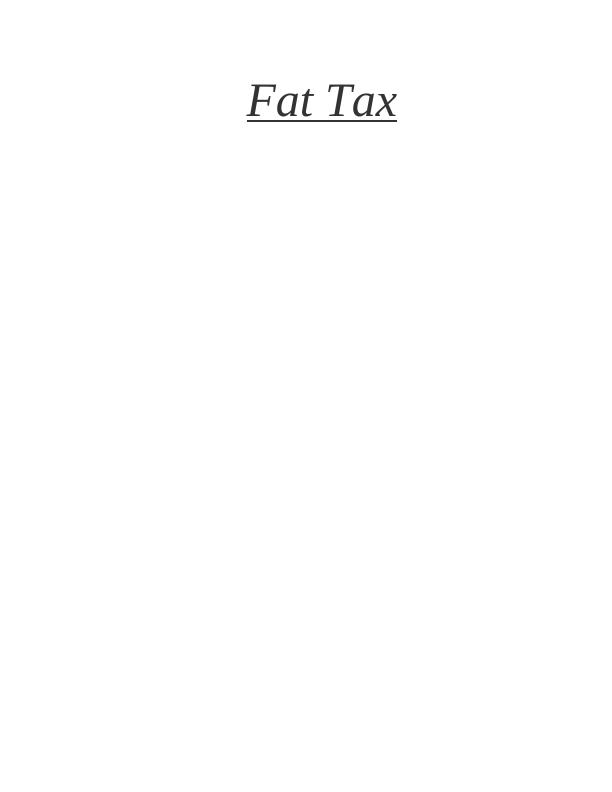Fat Tax: Combating Australia's Obesity Epidemic
Added on 2023-01-06
6 Pages1637 Words66 Views
Fat Tax


Fat taxes should be introduced to combat Australia’s obesity epidemic
Australia should pursue Denmark's initiative and look at taxing high-saturated foodstuffs
at mitigate the country 's rising obesity epidemic, Greens-leader Bob Brown stated on fiscal
forum. Denmark has added extra foodstuff levy, which involves butter, beef, milk, cheese,
oils and refined food, that contains upwards of 2.3 percent saturated fats. In country Australia,
obesity is growing concern, with overweighed or unhealthy in 2 out of 3 adults. It raises the
likelihood of chronic diseases like asthma, cardiovascular disorders and asthma. The Australian
Medical Association commissioned an online survey asking, after Denmark launched world's 1st
"fat tax" recently: could Australia lift tax on fatty foods? around 70% of 1032 voters replied
"yes" as well as around 30% "no", which suggests a significant increase in price of junk foods.
Despite Australian citizens being among fattest people on earth – and fat tax not on table, with a
quarter of children now overweight. Obesity is mainly driven by food supply, especially the
growing supply of inexpensive, delicious and high-quality foods. According to Alemanno &
Carreño (2013), Obesity requires to be tackled immediately – and growing price of unhealthy
items is a means of dissuading customers from preferring bad dietary choices. As overweight as
well as obesity rise in more nations, fat taxes have been imposed on unhealthful foods as well as
sweetened drinks to try to decrease the increasing impact of obesity issues on health. Take into
account the possible impact of food junk levy. Researchers assert that a 20 percent tax on soft
drinks can is sufficient to prevent it from being bought. It is simple to analyze: in convenience
shop someone visits refrigerator to purchase drink and prepared to take taste and cost choice. It
becomes less alluring if soft drink is more costly than lower-fat milk or water-bottle, and we may
witness a transformation in purchasing behavior as well as decrease in obesity-promoting items.
As per the views of Boncinelli, Gerini, Pagnotta & Alfnes, (2017), Fat tax relates
to specific tax levied on food-items with elevated saturated fat or sugar drinks, which
contributors towards obesity issues. The primary goal is to reduce the use of unhealthful foods
attributed to obesity issues and certain health risks. a Obesity is the major risks to international
reported deaths by the World Health Organization during 2015. A further WHO survey has
shown that globally rates of overweight as well as obesity affected approximately 1,9 million.
Investigators have demonstrated that people are at rising risk of overweight due to unhealthy
food choices. Obesity issues and overweigh are not just a result of poor food choices, but has led
Australia should pursue Denmark's initiative and look at taxing high-saturated foodstuffs
at mitigate the country 's rising obesity epidemic, Greens-leader Bob Brown stated on fiscal
forum. Denmark has added extra foodstuff levy, which involves butter, beef, milk, cheese,
oils and refined food, that contains upwards of 2.3 percent saturated fats. In country Australia,
obesity is growing concern, with overweighed or unhealthy in 2 out of 3 adults. It raises the
likelihood of chronic diseases like asthma, cardiovascular disorders and asthma. The Australian
Medical Association commissioned an online survey asking, after Denmark launched world's 1st
"fat tax" recently: could Australia lift tax on fatty foods? around 70% of 1032 voters replied
"yes" as well as around 30% "no", which suggests a significant increase in price of junk foods.
Despite Australian citizens being among fattest people on earth – and fat tax not on table, with a
quarter of children now overweight. Obesity is mainly driven by food supply, especially the
growing supply of inexpensive, delicious and high-quality foods. According to Alemanno &
Carreño (2013), Obesity requires to be tackled immediately – and growing price of unhealthy
items is a means of dissuading customers from preferring bad dietary choices. As overweight as
well as obesity rise in more nations, fat taxes have been imposed on unhealthful foods as well as
sweetened drinks to try to decrease the increasing impact of obesity issues on health. Take into
account the possible impact of food junk levy. Researchers assert that a 20 percent tax on soft
drinks can is sufficient to prevent it from being bought. It is simple to analyze: in convenience
shop someone visits refrigerator to purchase drink and prepared to take taste and cost choice. It
becomes less alluring if soft drink is more costly than lower-fat milk or water-bottle, and we may
witness a transformation in purchasing behavior as well as decrease in obesity-promoting items.
As per the views of Boncinelli, Gerini, Pagnotta & Alfnes, (2017), Fat tax relates
to specific tax levied on food-items with elevated saturated fat or sugar drinks, which
contributors towards obesity issues. The primary goal is to reduce the use of unhealthful foods
attributed to obesity issues and certain health risks. a Obesity is the major risks to international
reported deaths by the World Health Organization during 2015. A further WHO survey has
shown that globally rates of overweight as well as obesity affected approximately 1,9 million.
Investigators have demonstrated that people are at rising risk of overweight due to unhealthy
food choices. Obesity issues and overweigh are not just a result of poor food choices, but has led

End of preview
Want to access all the pages? Upload your documents or become a member.
Related Documents
The Failure of Fat Tax in Denmark: An Analysis of Negative Consumption Externalitylg...
|10
|2148
|305
Child OBESITY AND ITS MEASURES HEALTHCARElg...
|16
|769
|16
HEALTH CRISIS BLAME THE SYSTEMlg...
|4
|863
|18
Sugar Tax: A Health Service Plan to Control Sugar Intakelg...
|9
|2996
|91
